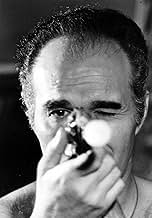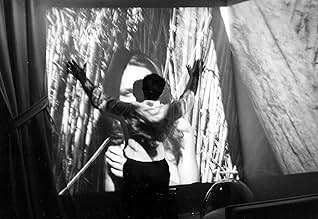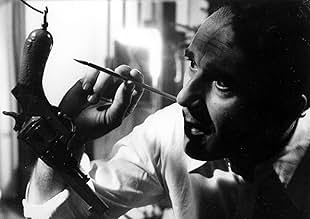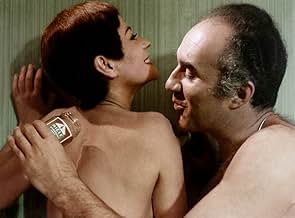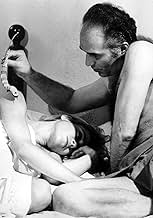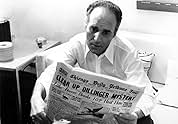Un homme décide de se préparer à manger, mais s'interrompt en trouvant le revolver de John Dillinger caché dans sa cuisine.Un homme décide de se préparer à manger, mais s'interrompt en trouvant le revolver de John Dillinger caché dans sa cuisine.Un homme décide de se préparer à manger, mais s'interrompt en trouvant le revolver de John Dillinger caché dans sa cuisine.
- Prix
- 1 victoire et 2 nominations au total
Avis en vedette
Dillinger is Dead (Dillinger e Morto) is a Marco Ferreri film. I just saw the film in a very good print at the Museum of Modern Art in New York, and this is a film that benefits from being seen in a cinema where there are less distractions, and a film of this pace and sensibility has a better chance of seizing you and bringing you into its unique and power logic.
The film, in my estimation, is a meditation on alienation in a period of increasing mass media saturation. The film artfully weaves in a multitude of media moments, including television, home movies, radio, records, newsreels, and newspapers. At a certain point in watching the film, I deeply appreciated how Ferreri forces us to consider not only his character's relationship to media, but our own relationship to media. In his most expressive audio-visual moments, this film moves away from any standard narrative formula into a subjective exploration of the power of cinema and its affect on our psyche and our actions. At those moments, the film is visually mesmerizing, sonically engaging and psychologically intimate. One scene of a projected home movie on the wall of his living room is one of the best sequences of its sort that I have ever seen.
This film opens with Glauco (Michel Piccoli) at his job, testing gas masks. The conversation between Glauco and one of his co-workers that opens the film highlights the theme of alienation, and the film right from the beginning establishes a tone that engages the fate of man in a society of the spectacle.
The film then takes place over one night in the life of Glauco. We watch as he comes home and spurns a dinner that is waiting for him. He goes upstairs to his bedroom, where he has a brief, though telling, encounter with his wife, played by Anita Pallenberg. The bedroom scene begins to establish the basic strategy of Ferreri's film. There is very little dialog between Glauco and his wife (In fact, there is very little dialog in the film at all, it verges on being an almost non-dialog driven film). Instead, we, in the audience, bare witness to their interaction, and our feelings of what we are seeing are impacted by source music emanating from a radio that Glauco's wife is listening to (Most, thought not all, of the music used in the film is produced by known sources seen in the film). The music in the scene is mostly contemporary Italian pop music and American pop music. The songs lend an interesting narrative counterpoint to this scene (and is true in other scenes as well), as the music is usually expressive of the unspoken feelings and emotions between Glauco and his wife. When Glauco goes back downstairs, he begins to prepare his own meal, which actually turns out to be quite a production. When Glauco goes searching for a particular spice, he accidentally knocks down a stack of old magazines in the spice closet, and a mysterious package, wrapped in newspaper, spills onto the floor. In one of Ferreri's most deft storytelling touches, the content of that package and Glauco's reaction to it, becomes a structuring element for this film. But it is clear that Ferreri's passion here is not some genre formula film, rather the film is an essayistic exploration of alienation, told through a seemingly simple night in the life of Glauco.
The performances in this film are uniformly excellent, beginning with Piccoli's lead performance that carries the film. Pallenberg isn't given much screen time, but she does a good job in a limited part. But Glauco's maid, played by Annie Girardot, has a couple of great scenes that add a juicy spark to this tale.
In fact, while the film does move in its own way towards a conclusion, I found a short moment when Glauco stops in front of a poster celebrating Italian Futurists to be very telling of Ferreri's intentions. The Futurists were obsessed with speed, and modernity, and cinema, and their manifestos would hold much appeal for a character such as Glauco. But it is clear in Dillinger is Dead how much has changed since the 1930s when modernity seemed to hold unchecked promises. By the end of the 1960s, that type of Utopian celebration of modernity was no longer as easy to summon. The society of the spectacle was beginning to encroach on all aspects of everyday life, and in a character like Glauco, in the depths of his alienation, we see that the line between fantasy and reality in our culture was already well on its way to eroding by the end of the 1960s.
The film, in my estimation, is a meditation on alienation in a period of increasing mass media saturation. The film artfully weaves in a multitude of media moments, including television, home movies, radio, records, newsreels, and newspapers. At a certain point in watching the film, I deeply appreciated how Ferreri forces us to consider not only his character's relationship to media, but our own relationship to media. In his most expressive audio-visual moments, this film moves away from any standard narrative formula into a subjective exploration of the power of cinema and its affect on our psyche and our actions. At those moments, the film is visually mesmerizing, sonically engaging and psychologically intimate. One scene of a projected home movie on the wall of his living room is one of the best sequences of its sort that I have ever seen.
This film opens with Glauco (Michel Piccoli) at his job, testing gas masks. The conversation between Glauco and one of his co-workers that opens the film highlights the theme of alienation, and the film right from the beginning establishes a tone that engages the fate of man in a society of the spectacle.
The film then takes place over one night in the life of Glauco. We watch as he comes home and spurns a dinner that is waiting for him. He goes upstairs to his bedroom, where he has a brief, though telling, encounter with his wife, played by Anita Pallenberg. The bedroom scene begins to establish the basic strategy of Ferreri's film. There is very little dialog between Glauco and his wife (In fact, there is very little dialog in the film at all, it verges on being an almost non-dialog driven film). Instead, we, in the audience, bare witness to their interaction, and our feelings of what we are seeing are impacted by source music emanating from a radio that Glauco's wife is listening to (Most, thought not all, of the music used in the film is produced by known sources seen in the film). The music in the scene is mostly contemporary Italian pop music and American pop music. The songs lend an interesting narrative counterpoint to this scene (and is true in other scenes as well), as the music is usually expressive of the unspoken feelings and emotions between Glauco and his wife. When Glauco goes back downstairs, he begins to prepare his own meal, which actually turns out to be quite a production. When Glauco goes searching for a particular spice, he accidentally knocks down a stack of old magazines in the spice closet, and a mysterious package, wrapped in newspaper, spills onto the floor. In one of Ferreri's most deft storytelling touches, the content of that package and Glauco's reaction to it, becomes a structuring element for this film. But it is clear that Ferreri's passion here is not some genre formula film, rather the film is an essayistic exploration of alienation, told through a seemingly simple night in the life of Glauco.
The performances in this film are uniformly excellent, beginning with Piccoli's lead performance that carries the film. Pallenberg isn't given much screen time, but she does a good job in a limited part. But Glauco's maid, played by Annie Girardot, has a couple of great scenes that add a juicy spark to this tale.
In fact, while the film does move in its own way towards a conclusion, I found a short moment when Glauco stops in front of a poster celebrating Italian Futurists to be very telling of Ferreri's intentions. The Futurists were obsessed with speed, and modernity, and cinema, and their manifestos would hold much appeal for a character such as Glauco. But it is clear in Dillinger is Dead how much has changed since the 1930s when modernity seemed to hold unchecked promises. By the end of the 1960s, that type of Utopian celebration of modernity was no longer as easy to summon. The society of the spectacle was beginning to encroach on all aspects of everyday life, and in a character like Glauco, in the depths of his alienation, we see that the line between fantasy and reality in our culture was already well on its way to eroding by the end of the 1960s.
In pop-culture, 1969 was a year of extremes. In August we experienced the very peaceful mass-event of Woodstock, and in December a black guy was killed during a Rolling Stones-concert. Thereafter the magic of the 1960s vanished.
Coincidence or not, 'Dillinger è morto' clearly reflects this sharp bend in the public appreciation of those days. Showing a glittering performance by male lead Michel Piccoli -- assisted by a credible role for Annie Girardot, all in Ferreri's good picturing.
The third lead in this film is Anita Pallenberg. She depends more on her looks than on her acting. And also lending a decadent touch to 'Dillinger è morto', in 1969 Pallenberg was reputed as the love-girl of three Rolling Stones ...
Coincidence or not, 'Dillinger è morto' clearly reflects this sharp bend in the public appreciation of those days. Showing a glittering performance by male lead Michel Piccoli -- assisted by a credible role for Annie Girardot, all in Ferreri's good picturing.
The third lead in this film is Anita Pallenberg. She depends more on her looks than on her acting. And also lending a decadent touch to 'Dillinger è morto', in 1969 Pallenberg was reputed as the love-girl of three Rolling Stones ...
with the "Grande abbuffata" title this is the best ferreri movie. Incredible tour de force real time movie is a study in alienation like no other one in cinema. Piccoli display a portfolio of frustrate-tipe tics with excellent performance. the same for annie girardot, the waitress in love with the Italian singer dino. Ferreri use no dialogues, the figure of dillinger as a mythical phantom over the alienated life of the protagonist. The final is incredibly surreal but all the film is terribly realistic and punctual, in line with the analysis of the contemporary man in the west society. I think that in today cinema this movie is something of irripetible
Although idiosyncratic and decidedly off beat, Marco Ferreri realised the importance of star names and following the international success of this, his first film to feature Michel Piccoli, the actors who entrusted themselves to his direction were not only extremely talented but like Piccoli were not afraid to push the boundaries and take chances. Of course Piccoli's inherent quirkiness makes him ideal casting whilst the emphasis in this on mundane domestic activity might be tedious were it not for his mesmerising performance.
As an avowed communist Ferreri's films became even more anarchic as time went on but here the anarchy is more controlled and is essentially a study in alienation, the entrapment of Marriage and the way in which so-called technological advances merely serve to repress the human spirit.
Anton Chekhov's maxim that once a gun is introduced it must at some stage inevitably go off is realised to devastating effect here and the low-key, almost clinical way in which the weapon is eventually used still shocks fifty years on.
Piccoli is supported by the equally quirky and courageous Annie Girardot as his obliging maid and as his wife the delectable Anita Pallenburg who has been used on the poster as the film's 'come on'.
This director's most famous (and infamous) opus is 'La Grande Bouffe' but there are many who consider this earlier work to be his greatest achievement.
Looking at Ferreri's depictions of urban angst calls to mind Thoreau's 'The mass of men lead lives of quiet desperation.'
As an avowed communist Ferreri's films became even more anarchic as time went on but here the anarchy is more controlled and is essentially a study in alienation, the entrapment of Marriage and the way in which so-called technological advances merely serve to repress the human spirit.
Anton Chekhov's maxim that once a gun is introduced it must at some stage inevitably go off is realised to devastating effect here and the low-key, almost clinical way in which the weapon is eventually used still shocks fifty years on.
Piccoli is supported by the equally quirky and courageous Annie Girardot as his obliging maid and as his wife the delectable Anita Pallenburg who has been used on the poster as the film's 'come on'.
This director's most famous (and infamous) opus is 'La Grande Bouffe' but there are many who consider this earlier work to be his greatest achievement.
Looking at Ferreri's depictions of urban angst calls to mind Thoreau's 'The mass of men lead lives of quiet desperation.'
Wealthy, middle-aged gas-mask maker Michel Piccoli (as Glauco) arrives home late from work and finds his beautiful blonde wife in bed with a headache. While she blows kisses to her goldfish, Mr. Piccoli rejects the dinner she left and decides to make a hot gourmet meal. Gathering ingredients, Mr. Piccoli opens a closet door and some poorly-stacked newspapers fall out onto the floor. Restacking the items, Piccoli finds an unexpected object wrapped in a newspaper containing an article on the death of 1930s US gangster John Dillinger. This is where director Marco Ferreri derives "Dillinger Is Dead" as a title. Piccoli is intrigued by his newspaper discovery and it ends up changing his life...
Mr. Ferreri and Piccoli appear to be having fun with this arty film. They may have been having a little too much fun. It starts out with some rather explicit references to a theme. You could call it "the alienation of modern man," and Ferreri does appear to be naming that as his thesis. Later, it veers perilously close to a mid-life crisis. The protagonist is difficult to identify with; possibly, he's too bourgeois. Some scenes move as slow as molasses or, as you'll see, honey. A "finger dance" segment enlivens an otherwise dull portion; it's pointless, but that's what fingers do. This viewer narrowed it down to two options for Glauco, considering his discovery. Not sure he made the best choice.
****** Dillinger Is Dead (1/23/1969) Marco Ferreri ~ Michel Piccoli, Annie Girardot, Anita Pallenberg, Gino Lavagetto
Mr. Ferreri and Piccoli appear to be having fun with this arty film. They may have been having a little too much fun. It starts out with some rather explicit references to a theme. You could call it "the alienation of modern man," and Ferreri does appear to be naming that as his thesis. Later, it veers perilously close to a mid-life crisis. The protagonist is difficult to identify with; possibly, he's too bourgeois. Some scenes move as slow as molasses or, as you'll see, honey. A "finger dance" segment enlivens an otherwise dull portion; it's pointless, but that's what fingers do. This viewer narrowed it down to two options for Glauco, considering his discovery. Not sure he made the best choice.
****** Dillinger Is Dead (1/23/1969) Marco Ferreri ~ Michel Piccoli, Annie Girardot, Anita Pallenberg, Gino Lavagetto
Le saviez-vous
- AnecdotesThe interiors shown in the film are almost entirely those of the apartment once belonged to Italian Postmodern artist Mario Schifano. Some of his paintings can be seen hanging on the walls of the house. The kitchen scenes were shot into a country villa belonged to actor Ugo Tognazzi, good friend with director Marco Ferreri and frequently cast in his films.
- GaffesHe is 'cooking' in an empty saucepan; the spatula is clean and dry.
- ConnexionsEdited into Spisok korabley (2008)
Meilleurs choix
Connectez-vous pour évaluer et surveiller les recommandations personnalisées
- How long is Dillinger Is Dead?Propulsé par Alexa
Détails
- Date de sortie
- Pays d’origine
- Langue
- Aussi connu sous le nom de
- Dillinger Is Dead
- Lieux de tournage
- Palazzo ENI, Rome, Lazio, Italie(opening sequence)
- sociétés de production
- Consultez plus de crédits d'entreprise sur IMDbPro
- Durée1 heure 35 minutes
- Mixage
- Rapport de forme
- 1.37 : 1
Contribuer à cette page
Suggérer une modification ou ajouter du contenu manquant

Lacune principale
By what name was Dillinger è morto (1969) officially released in India in English?
Répondre


